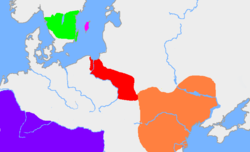Greuthungi

The Greuthungs, Greuthungi, or Greutungi were a Gothic people of the Ukrainian steppes in the 3rd and the 4th centuries. They had close contacts with the Thervingi, another Gothic people, from west of the Dniester River. They may be the same people as the later Ostrogoths.
Etymology
"Greuthungi" may mean "steppe dwellers" or "people of the pebbly coasts".[1] The root greut- is probably related to the Old English greot, meaning "gravel, grit, earth" Polish grunt land, earth, ground [2] This is supported by evidence that geographic descriptors were commonly used to distinguish people living north of the Black Sea both before and after Gothic settlement there and by the lack of evidence for an earlier date for the name pair Tervingi-Greuthungi than the late third century.[3] It is also possible that the name "Greuthungi" has pre-Pontic Scandinavian origins.[3] It may mean "rock people", to distinguish the Ostrogoths from the Gauts (in what is today Sweden).[3] Jordanes does refer to an Evagreotingi (Greuthung island) in Scandza, but this may be legend. It has also been suggested that it may be related to certain place names in Poland, but this has met with little support.[3]
History
Jordanes, a mid 6th-century historian identifies the 4th-century Greuthungi with the 5th/6th-century Ostrogothi. Jordanes also describes a large Greuthung kingdom in the late 4th-century, but Ammianus Marcellinus, a late 4th-century historian, does not record this. Many modern historians, including Peter Heather and Michael Kulikowski, doubt that it was ever particularly extensive (and suggest one or more smaller kingdoms).[4][5]
Archaeology
In time and geographical area, the Greutungi and their neighbours, the Thervingi, correspond to the archaeological Chernyakhov culture.
Settlement pattern
Chernyakhov settlements cluster in open ground in river valleys. The houses include sunken-floored dwellings, surface dwellings, and stall-houses. The largest known settlement (Budesty) is 35 hectares.[6] Most settlements are open and unfortified; some forts are also known.[citation needed]
Burial practices
Chernyakhov cemeteries include both cremation and inhumation burials in which the head is to the north. Some graves were left empty. Grave goods often include pottery, bone combs, and iron tools but almost never any weapons.[7]
Relationship with Ostrogoths
The division of the Goths is first attested in 291.[8] The Greuthungi are first named by Ammianus Marcellinus, writing no earlier than 392 and perhaps later than 395 and basing his account of the words of a Tervingian chieftain attested as early as 376.[8] The Ostrogoths are first named in a document dated September 392 from Milan.[8] Claudian mentions that they and the Gruthungi inhabit Phrygia.[9] According to Herwig Wolfram, the primary sources either use the terminology of Tervingi/Greuthungi or Vesi/Ostrogothi and never mix the pairs.[8] All four names were used together, but the pairing was always preserved, as in Gruthungi, Austrogothi, Tervingi, Visi.[1]
Both Herwig Wolfram and Thomas Burns conclude that the term Greuthungi was a geographical identifier used by the Tervingi to describe a people that described itself as the Ostrogoths.[1][10] The terminology dropped out of use after the Goths were displaced by the Hunnic invasions. In support of this, Wolfram cites Zosimus as referring to a group of "Scythians" north of the Danube who were called "Greuthungi" by the barbarians north of the Ister.[11] Wolfram concludes that it was the Tervingi who had remained behind after the Hunnic conquest.[11] On this understanding, the Greuthungi and Ostrogothi were more or less the same people.[10]
That the Greuthungi were the Ostrogothi is also supported by Jordanes.[12] He identified the Ostrogothic kings from Theodoric the Great to Theodahad as the heirs of the Greuthungian king Ermanaric. That interpretation is very common among scholars today, is not universal. The nomenclature of Greuthungi and Tervingi fell out of use shortly after 400.[8] In general, the terminology of a divided Gothic people disappeared gradually after it entered the Roman Empire.[1]
People
- Ermanaric (c. 370s), King
- Vithimiris (c. 376), King
- Alatheus and Saphrax (fl. 376–387), chieftains
See also
References
- ^ a b c d Herwig Wolfram, History of the Goths, trans. T. J. Dunlop (Berkeley, University of California Press, 1988), p. 25.
- ^ Thomas S. Burns, A History of the Ostrogoths (Bloomington: Indiana University Press, 1984), p. 30.
- ^ a b c d Wolfram387–388 n58.
- ^ Heather, Peter, 1998, The Goths, Blackwell, Malden, pp. 53-55.
- ^ Kulikowski, Michael, 2007, Rome's Gothic Wars, Cambridge University Press: Cambridge, pp. 54-56, 111-112.
- ^ Heather, Peter and Matthews, John, 1991, The Goths in the Fourth Century, Liverpool, Liverpool University Press, pp. 52-54.
- ^ Heather, Peter and Matthews, John, 1991, Goths in the Fourth Century, Liverpool, Liverpool University Press, pp. 54-56.
- ^ a b c d e Wolfram, 24.
- ^ Wolfram, 387 n52.
- ^ a b Burns, 44.
- ^ a b Wolfram, 387 n57.
- ^ Heather, 52–57, 300–301.
